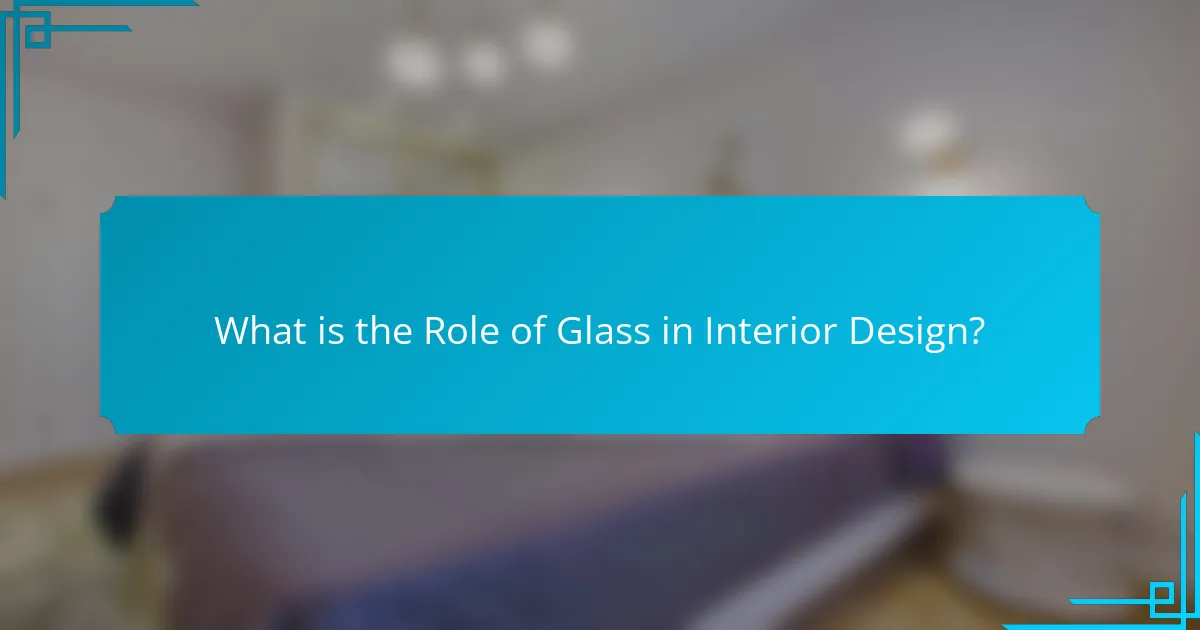Glass is a versatile material that significantly impacts interior design by enhancing both aesthetics and functionality. Its ability to allow natural light into spaces creates an open atmosphere while visually expanding small areas. The article explores various forms of glass, such as windows, walls, and furniture, and discusses aesthetic considerations like transparency, texture, and color. Additionally, it addresses safety aspects, including the risks of breakage and the importance of using tempered and safety glazing. Understanding these elements is essential for effectively incorporating glass into interior spaces while ensuring safety and design harmony.

What is the Role of Glass in Interior Design?
Glass plays a crucial role in interior design by enhancing aesthetics and functionality. It allows natural light to enter spaces, creating an open and airy atmosphere. Glass can be used in various forms, such as windows, walls, and furniture. Its transparency can visually expand small areas, making them appear larger. Additionally, glass surfaces are easy to clean and maintain. They can also be treated for energy efficiency, reducing heating and cooling costs. The use of glass contributes to modern design trends, emphasizing minimalism and elegance. Overall, glass is a versatile material that balances beauty and practicality in interior spaces.
How does glass contribute to the overall aesthetic of a space?
Glass enhances the overall aesthetic of a space by providing transparency and lightness. It allows natural light to penetrate, creating a bright and open atmosphere. This transparency can visually expand smaller areas, making them appear larger. Glass surfaces reflect and refract light, adding dynamic visual interest. Various finishes and tints can create distinct moods and styles. Additionally, glass can integrate with other materials, enhancing their visual appeal. Architectural designs often incorporate glass for a modern and sleek look. Statistics show that spaces with ample natural light are perceived as more inviting and pleasant.
What visual effects can glass create in interior environments?
Glass can create a range of visual effects in interior environments. It enhances natural light, making spaces feel larger and more open. Reflective surfaces can create interesting light patterns and shadows. Frosted glass adds privacy while still allowing light to filter through. Stained glass introduces color and artistic elements to a space. Transparent glass can connect indoor and outdoor areas, blurring boundaries. Textured glass creates depth and visual intrigue. The use of glass can also emphasize architectural features and design elements. These effects contribute to the overall aesthetic and functionality of interior spaces.
How does the transparency of glass influence light and space perception?
The transparency of glass significantly influences light and space perception. Transparent glass allows natural light to enter a space, enhancing brightness. Increased light can make areas feel more open and inviting. It also creates a visual connection between indoor and outdoor environments. This connection can expand perceived space, making smaller rooms appear larger. Additionally, transparency can reduce the need for artificial lighting during the day. In architectural design, the use of glass can create a sense of fluidity and continuity. Studies show that spaces with ample natural light improve mood and productivity. Overall, the transparency of glass plays a crucial role in shaping spatial experiences.
What are the different types of glass used in interiors?
The different types of glass used in interiors include tempered glass, laminated glass, frosted glass, and clear glass. Tempered glass is heat-treated for strength and safety. It shatters into small, blunt pieces when broken. Laminated glass consists of two or more layers bonded with a plastic interlayer. This type provides sound insulation and UV protection. Frosted glass has a translucent finish, offering privacy while allowing light to pass through. Clear glass is uncoated and transparent, commonly used in windows and doors. Each type serves specific aesthetic and functional purposes in interior design.
What are the characteristics of tempered glass?
Tempered glass is a type of safety glass that is processed by controlled thermal treatments. This process increases its strength compared to standard glass. It is highly resistant to thermal stress and can withstand high temperatures. When broken, tempered glass shatters into small, blunt pieces, reducing the risk of injury. It also offers improved resistance to impact and is less likely to break under stress. Tempered glass is commonly used in applications such as shower doors, glass doors, and facades due to its safety features. Its strength and safety characteristics make it a preferred choice in interior design.
How does laminated glass differ from other types?
Laminated glass differs from other types by its construction, which includes multiple layers of glass bonded with an interlayer. This design enhances safety, as it holds together when shattered, reducing the risk of injury from sharp shards. In contrast, tempered glass shatters into small pieces, and annealed glass breaks into larger, sharper shards. Laminated glass also provides better sound insulation due to the interlayer, which absorbs sound waves. Additionally, it offers UV protection, blocking up to 99% of harmful rays. These attributes make laminated glass a preferred choice for safety and acoustics in various interior applications.

What Aesthetic Considerations Should Be Made When Using Glass?
Aesthetic considerations when using glass include transparency, texture, and color. Transparency allows light to flow through, enhancing spatial perception. Textured glass adds visual interest and can diffuse light. Color can influence mood and ambiance, with options ranging from clear to tinted or frosted. The design should harmonize with surrounding materials like wood or metal. Scale and proportion are crucial; oversized glass features can dominate a space. Lighting plays a significant role; backlighting can create stunning effects. Lastly, the style should align with the overall design theme, whether modern, traditional, or eclectic.
How can color and texture impact the use of glass in interiors?
Color and texture significantly influence the use of glass in interiors. Color affects the mood and perception of space. For instance, warm colors can create a cozy atmosphere, while cool colors promote calmness. Textured glass can diffuse light, enhancing privacy while maintaining brightness. This is particularly beneficial in bathrooms or office spaces. Moreover, colored glass can serve as a focal point, drawing attention to specific areas or features. The interplay of color and texture can also complement other materials in a room, creating a cohesive design. Ultimately, these elements together enhance both functionality and aesthetic appeal in interior design.
What are the effects of frosted versus clear glass in design?
Frosted glass diffuses light, creating a softer ambiance, while clear glass allows for maximum visibility and natural light. Frosted glass enhances privacy, making it ideal for bathrooms and office spaces. Clear glass, on the other hand, opens up spaces and provides unobstructed views. The choice between the two affects the overall aesthetic and functionality of a design. For instance, frosted glass can add a modern touch while reducing glare. Clear glass can create a sense of openness and airiness in a room. Research indicates that the use of frosted glass can improve comfort levels in spaces by minimizing harsh lighting. Each type of glass serves distinct purposes in interior design, influencing both mood and usability.
How does the choice of glass thickness affect aesthetic outcomes?
The choice of glass thickness significantly affects aesthetic outcomes. Thicker glass provides a more substantial and luxurious appearance. It enhances the perception of quality in design. Thicker glass can also reduce distortion, leading to clearer views. This clarity contributes to a more elegant and refined look in interiors. Conversely, thinner glass can create a lighter, more delicate aesthetic. It allows for more light transmission, which can enhance brightness in a space. The visual weight of glass influences the overall ambiance and style of the interior. Ultimately, the thickness of glass should align with the desired aesthetic vision of the space.
Why is the integration of glass with other materials important?
The integration of glass with other materials is important for enhancing functionality and aesthetics. Glass provides transparency and light transmission, while other materials add structural support and insulation. This combination improves energy efficiency in buildings. For instance, glass and metal facades are common in modern architecture. They offer durability and weather resistance. Moreover, integrating glass with wood creates a warm, inviting atmosphere. This blend is often seen in residential interiors. The use of glass with concrete can also create striking visual contrasts. Such combinations allow for creative design possibilities. Therefore, integrating glass with other materials enriches both the performance and appearance of interior spaces.
What materials pair well with glass in interior design?
Wood, metal, and stone pair well with glass in interior design. Wood adds warmth and texture, creating a cozy atmosphere. Metal introduces a sleek, modern contrast to glass. Stainless steel or aluminum frames enhance the contemporary look. Stone elements, such as marble or granite, provide a natural and elegant touch. These materials complement glass by balancing transparency with solidity. Their combination creates visually appealing spaces that are both functional and stylish.
How does the combination of glass and wood influence design themes?
The combination of glass and wood significantly influences design themes by creating a balance between transparency and warmth. Glass adds a modern, airy feel to spaces, while wood introduces natural elements and texture. This contrast enhances visual interest and depth in interior design. For instance, large glass windows framed with wooden trim can create a seamless connection between indoor and outdoor environments. Additionally, the pairing of these materials can evoke a sense of harmony and sophistication. Research indicates that spaces featuring both glass and wood often promote well-being and comfort, as they combine natural light with organic materials. This blend is commonly found in contemporary and minimalist design themes, emphasizing sustainability and aesthetic appeal.

What Safety Considerations Are Associated with Glass in Interiors?
Safety considerations associated with glass in interiors include breakage risk and sharp edges. Glass can shatter upon impact, posing injury risks. Tempered glass is often used to mitigate this hazard. It is designed to break into small, less harmful pieces. Additionally, safety glazing is recommended in high-traffic areas. This type of glass resists impact and minimizes injury. Proper installation is crucial to prevent accidents. Regular maintenance checks can identify potential issues. Overall, understanding these safety aspects is vital for ensuring a secure environment.
How can the risk of glass breakage be minimized?
To minimize the risk of glass breakage, use tempered or laminated glass. Tempered glass is treated to withstand higher stress and impact. Laminated glass consists of layers that hold together when shattered. Proper installation is crucial; ensure glass is securely fitted in frames. Use protective films to reinforce glass surfaces. Regular maintenance checks can identify potential weaknesses. Avoid placing heavy objects near glass installations. Educate occupants about safe handling practices around glass. These measures significantly reduce the likelihood of breakage.
What safety standards should be followed for glass installation?
Safety standards for glass installation include compliance with the ASTM E1300 standard. This standard evaluates the structural performance of glass under load. It ensures that glass can withstand wind pressure and other forces. Additionally, the safety glass standard, ANSI Z97.1, specifies requirements for safety glazing materials. This standard addresses impact resistance and minimizes injury risk. Another important guideline is the International Building Code (IBC), which outlines installation requirements for glass in buildings. Following these standards reduces the likelihood of glass breakage and enhances safety. Regular inspections and maintenance are also recommended to ensure ongoing compliance.
How does the choice of glass type affect safety in high-traffic areas?
The choice of glass type significantly affects safety in high-traffic areas. Tempered glass is more resistant to impact and shattering compared to regular glass. This durability reduces the risk of injury from broken glass. Laminated glass, which consists of layers, holds together when shattered. This feature prevents sharp shards from causing harm. Safety glass types meet specific standards for strength and safety. For instance, safety glass is often required in commercial settings to minimize injury risks. The use of appropriate glass types in high-traffic areas can reduce accidents and enhance overall safety.
What are the implications of using glass in family-friendly spaces?
Using glass in family-friendly spaces can enhance aesthetics and functionality. Glass allows for natural light, creating a bright and inviting atmosphere. However, safety concerns arise due to the fragility of glass. Sharp edges and breakage can pose risks to children. Using tempered or laminated glass can mitigate these dangers. Additionally, the transparency of glass can lead to privacy issues. Ensuring that glass is appropriately placed and treated is essential for family safety. Studies indicate that well-designed glass installations can improve overall space usability without compromising safety.
How can design choices enhance safety for children and pets?
Design choices can enhance safety for children and pets by incorporating features that minimize risks. For example, using tempered glass reduces the likelihood of injury from breakage. Rounded edges on furniture can prevent cuts and bruises. Non-slip flooring can reduce the chances of slips and falls. Additionally, safety gates can restrict access to hazardous areas. Properly placed furniture can create safe play zones. Using child-proof locks on cabinets can prevent access to dangerous items. These design elements collectively contribute to a safer environment for both children and pets.
What Best Practices Should Be Followed When Incorporating Glass in Interiors?
Use tempered or laminated glass for safety in interiors. These types are less likely to shatter and cause injury. Ensure proper installation to prevent accidents. Utilize glass in areas with adequate support to avoid structural issues. Incorporate glass panels to enhance natural light and create a sense of space. Consider the thickness of the glass based on its application, as thicker glass offers more durability. Use frosted or tinted glass for privacy while maintaining light flow. Regularly clean and maintain glass surfaces to preserve their appearance and functionality.
How can one effectively choose glass types based on functionality and design goals?
To effectively choose glass types based on functionality and design goals, one must first identify the specific requirements of the project. Consider whether the glass needs to provide safety, insulation, or aesthetic appeal. For example, tempered glass is ideal for safety in high-traffic areas. Laminated glass offers sound insulation and UV protection, making it suitable for residential applications.
Next, evaluate the design goals. Clear glass enhances natural light and creates an open feel. Frosted or patterned glass adds privacy while still allowing light to pass through.
Lastly, assess the environmental factors. Low-emissivity (Low-E) glass improves energy efficiency by reflecting heat. This is particularly beneficial in climates with extreme temperatures.
By aligning the glass type with the project’s functionality and design objectives, one can achieve both practical and visual success.
What maintenance tips ensure the longevity and safety of glass installations?
Regular cleaning of glass installations is essential for longevity and safety. Use a soft cloth and a non-abrasive cleaner to avoid scratches. Inspect the glass for cracks or chips periodically. Address any damage immediately to prevent further issues. Ensure that seals and frames are intact to maintain structural integrity. Avoid using harsh chemicals that can degrade the glass over time. Control environmental factors, such as humidity and temperature, to reduce stress on the glass. Following these tips can significantly enhance the lifespan and safety of glass installations.
The main entity of the article is glass and its application in interior design. The article provides a comprehensive overview of the various types of glass used in interiors, including tempered, laminated, frosted, and clear glass, highlighting their aesthetic and functional attributes. It discusses how glass enhances natural light, influences space perception, and integrates with other materials while addressing safety considerations associated with its use. Key topics include the visual effects of glass, aesthetic considerations, and best practices for ensuring safety and longevity in glass installations.